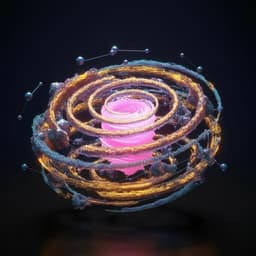
Physics
Moiré straintronics: a universal platform for reconfigurable quantum materials
M. Kögl, P. Soubelet, et al.
This groundbreaking research by M. Kögl, P. Soubelet, M. Brotons-Gisbert, A. V. Stier, B. D. Gerardot, and J. J. Finley unveils how strain can dramatically modify the periodicity and symmetry of moiré superlattices in quantum materials, offering unprecedented control over electronic interactions and phases.
Playback language: English
Introduction
Strong electron correlations emerge when Coulomb interactions rival or exceed kinetic energy. This delicate balance dictates the ground state and low-energy excitations. Moiré patterns, created by stacking 2D crystals with lattice mismatch or twist angle, offer tunability of these energy scales and electron density. Moiré materials, such as twisted bilayer graphene and transition metal dichalcogenide (TMD) heterostructures, showcase this potential. The Hubbard model, with hopping parameter *t* and on-site Coulomb repulsion *U*, provides a simplified understanding, but solving higher-dimensional cases requires precise control of parameters and lattice geometry. While 2D moiré materials offer advantages over ultracold atom optical lattices, the in situ tunability of lattice symmetry, *U*, and *t* remains limited. Existing techniques, such as displacement fields, only partially address this. This paper investigates heterostrain—differential strain between layers—as a means to directly influence moiré superlattices and tune *U*/t. Prior work mainly focused on unintentional strain or lacked in situ control. This research explores the effect of heterostrain on moiré lattice size and geometry using a generic analytical approach, examining biaxial, uniaxial, and shear heterostrains. The aim is to demonstrate the ability to tune moiré wavelength, modify lattice symmetry (e.g., from triangular to rectangular), and break symmetries to satisfy conditions for exotic quantum models. The ultimate goal is to leverage heterostrain to overcome fabrication variability and realize reconfigurable quantum materials for fully tunable on-chip quantum simulation.
Literature Review
The introduction extensively reviews existing literature on strongly correlated electron systems, moiré patterns in various 2D materials (including twisted bilayer graphene and TMD heterostructures), the Hubbard model and its limitations in higher dimensions, and existing attempts to tune parameters in moiré systems. It highlights the limitations of current methods and introduces heterostrain as a novel approach. The paper cites numerous studies demonstrating the emergence of novel physical properties in moiré materials, including unconventional superconductivity, correlated insulator behavior, Mott and Wigner crystal states, quantum anomalous Hall effects, moiré trapped excitons, twisted 2D magnets, and ferroelectric moiré materials. It contrasts the tunability of ultracold atom optical lattices with the limitations of existing techniques for 2D moiré materials, setting the stage for the introduction of heterostrain as a powerful new tool.
Methodology
The core methodology involves developing an analytically exact mathematical description of moiré lattice deformation under arbitrary in-plane heterostrain. The authors start by defining the Bravais lattice vectors for the lower and upper layers of a bilayer structure, considering lattice constant mismatch and twist angle. They then introduce a 2D strain tensor to represent the applied strain on the lower layer and a strain transfer parameter (µ) to account for slippage between layers. The strain tensor is parameterized using biaxial strain (εc), shear strain (εs), and shear angle (φs). The equations describing the transformation of the Bravais lattice vectors under strain are derived. A key contribution is the derivation of equations (5) and (7), which provide an exact, general expression for the moiré lattice vectors and unit cell area under arbitrary strain, applicable to any homo- or heterobilayer structure with similarly shaped unit cells. This general approach avoids approximations used in previous models that focused on specific strain configurations or hexagonal lattices. The model considers different strain scenarios: homostrain (µ = 1), where strain fully transfers between layers, and heterostrain (µ < 1), which is the focus of this work. The calculations are then applied to specific examples: WSe2 homobilayers and MoSe2-WSe2 heterobilayers, using realistic material parameters and analyzing the effects of biaxial, uniaxial, and shear heterostrains on moiré lattice size and geometry. The analysis uses visualizations of moiré lattice parameters as functions of strain and twist angle to illustrate the tunability of the system. Supplemental material provides details on the calculations, experimental implementations, and considerations of atomic reconstruction effects.
Key Findings
The research establishes that heterostrain is a powerful mechanism for in situ modification of moiré lattice periodicity and symmetry. The key findings are as follows:
1. **Analytical Model:** The authors developed an analytically exact mathematical description for moiré lattice deformation under arbitrary in-plane heterostrain, applicable to various bilayer systems.
2. **Biaxial Heterostrain:** Biaxial strain was found to modify the moiré wavelength (periodicity) in both homo- and heterobilayers, offering control over the moiré lattice size but preserving the hexagonal symmetry.
3. **Uniaxial Heterostrain:** Uniaxial strain demonstrated a more significant effect than biaxial strain. It was found to break the degeneracy of moiré lattice parameters and alter the moiré lattice geometry (e.g., creating rectangular lattices from hexagonal ones). It also revealed a divergence behavior in moiré parameters for both homo- and heterobilayers, but with key differences near zero strain. The dependence of this divergence on the Poisson ratio was highlighted.
4. **Shear Heterostrain:** Shear strain showed similar divergence behavior as uniaxial strain, allowing for the generation of 1D moiré lattices and significant control over moiré lattice geometry. The divergence points differed between homo- and heterobilayers reflecting the inherent lattice mismatch.
5. **Combined Strain Effects:** The combined effect of biaxial and shear strain provides extensive in situ control over both the size and shape of the moiré lattice, opening the possibility to tune the system into various desired configurations (rectangular, triangular, or 1D lattices). This combination allows for tuning of hopping parameters (t1 and t2) in a triangular Hubbard model or creating systems akin to a square lattice.
6. **Experimental Feasibility:** The study highlights that these findings are experimentally feasible using state-of-the-art strain tuning setups. Different clamping strategies for achieving specific types of strain are presented. The use of piezo response force microscopy is proposed as a suitable technique to verify the findings experimentally.
Discussion
The findings demonstrate that heterostrain provides a powerful new degree of freedom for tuning and probing strongly correlated quantum materials based on moiré superlattices. This surpasses the limitations of existing methods which primarily focus on tuning the twist angle after fabrication. Heterostrain offers superior precision and in situ control. The precise tuning of moiré lattice size and geometry allows for fine-tuning of the Hubbard model parameters (*U* and *t*), enabling exploration of the phase diagrams of various strongly correlated systems. The ability to create various moiré lattice geometries (rectangular, 1D, etc.) opens possibilities for exploring exotic quantum models beyond the standard Hubbard model. The avoided crossings observed in heterobilayers highlight the interplay between strain and the inherent lattice mismatch, suggesting a way to controllably manipulate the moiré landscape. This technique offers a route to overcome fabrication limitations and precisely achieve desired moiré structures near critical points in the phase diagram, particularly important for systems such as magic-angle graphene.
Conclusion
This research presents a significant advance in the field of moiré materials. The development of an analytically exact model for moiré lattice deformation under heterostrain, combined with demonstrations of its experimental feasibility, unlocks a new level of control over moiré superlattices. The ability to in situ tune both the size and shape of the moiré lattice offers unprecedented control over electronic interactions and lattice symmetry. This opens exciting new avenues for exploring strongly correlated quantum systems, fine-tuning existing materials, and potentially realizing novel moiré-based quantum simulators. Future work could focus on experimental verification of the model and on exploring the implications of these findings for various moiré-based devices and quantum phenomena.
Limitations
While the model presented is analytically exact under the assumption of rigid layers, it does not fully account for atomic reconstruction effects that can occur in some systems. The analysis focuses on specific types of 2D materials (WSe2 and MoSe2), and the generalizability to other materials requires further investigation. The model assumes uniform strain across the whole layer, which may not always be perfectly realized in experiments. Finally, while the experimental feasibility is discussed, detailed experimental results verifying the predictions of the model are not yet presented.
Related Publications
Explore these studies to deepen your understanding of the subject.







